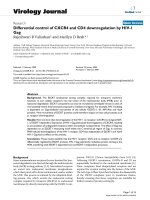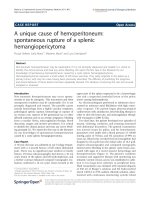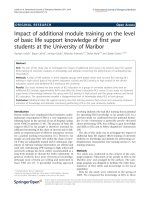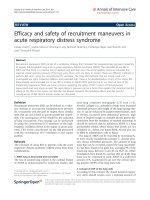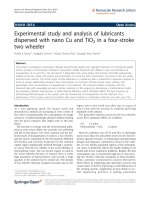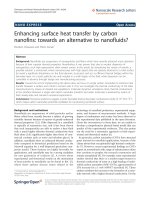Canales et al. Organic and Medicinal Chemistry Letters 2011, 1:9 docx
Bạn đang xem bản rút gọn của tài liệu. Xem và tải ngay bản đầy đủ của tài liệu tại đây (146.88 KB, 3 trang )
SHOR T COMMU N I C A TION Open Access
Bismuth nitrate pentahydrate-induced novel
nitration of eugenol
Luis Canales
†
, Debasish Bandyopadhyay
†
and Bimal K Banik
*
Abstract
Background: Eugenol, the main constituent of clove oil possesses a number of medicinal activities. To enhance
the medicinal property, structural modification is required. On the other hand, bismuth nitrate pentahydrate has
been establ ished as an excellent eco-friendly nitrating agent for several classes of organic compounds.
Results: Bismuth nitrate pentahydrate-induced nitration of eugenol has been investigated very thoroughly. Twenty
five different conditions have been studied. The microwave-induced solvent-free reaction has been identified as
the best condition.
Conclusions: Spectral analyses confirm that 5-nitroeugenol is the sole product in all the cases. No oxidized or
isomerized product could be detected.
Background
Syzygium aromaticum L., popularly know n as clove,
belongs to the plant family Myrtaceae, and has been used
in folk medicine and dental treatment. Eugenol (4-allyl-2-
methoxyphenol) , the main component of clove oil, is an
allyl chain-substituted guaiacol in the biosynthesized phe-
nylpropanoid compound class derived from Syzygium aro-
maticum L. and widely used in medicine [1]. It is widely
cultivated in India, Indonesia, Sri Lanka, Madagascar, and
Brazil. In addition, it is commonly used in root canal and
temporary fillings; it shows antibacterial activity, and helps
in dental caries t reatmen t and periodontal disease [ 2,3].
Clove oil has been successfully used for some breath pro-
blems [3]. It is slightly soluble in water and soluble in
organic solvents. A recent report [4] reveals the insectici-
dal effect of eugenol. Anti-inflammatory and antinocicep-
tive activiti es of eugenol have also b een reported [5].
Moreover, eugenol is reported to possess antioxidant and
anticancer properties [6].
In order to study the biological activities of eugenol deri-
vatives, nitration by conventional nitric acid-sulfuric acid
or a nitronium tetrafluoborate method were performed.
These reactions require a mixture of concentrated or fum-
ing nitric acid with sulfuric acid leading to excessive use of
hazardous chemicals [7]. Nitration of eugenol and its deri-
vatives was reported using HNO
3
/H
2
SO
4
[8] or by HNO
3
/
Et
2
O [9]. In addition, difficult work-up procedure and low
yield were also observed as a result of some other side
reactions.
On the other hand, the usefulness of clay-mediated
organic synthesis has been documented in a large num-
ber of publications which includes Michael addition
[10], regioselective synthesis of carbazoles [11], selective
hydrolysis of nucleosides [12], and Knoevenagel/hetero
Diels-Alder reaction [13]. We ha ve demonstrated the
use of trivalent bismuth nitrate pentahydrate in organic
synthesis. These experiments have resulted in various
methods that include protection of carbonyl compounds
[14], Michael reaction [15], nitration of aromatic sys-
tems [16], deprotection of oximes and hydrazones [17 ],
and Paal-Knorr synthesis of pyrroles [18]. Our success
in the bismuth nitrate-induced reaction has revealed
[19] that this reagent acts as a Lewis acid.
We have been studying metal/metal salts-mediated
reactions with the aim of developing several biologically
active compounds; including anticancer polyaromatic
compounds [20] and anticancer b-lactams [21]. Toward
this goal, we al so demonstrated that an effective bismuth
nitrate-mediated nitration of polycyclic aromatic hydro-
carbons. We reported the nitration of estrone with metal
salts which exclusively depends on the nature of the solid
surfaces [22]. Herein we report the direct nitration of
* Correspondence:
† Contributed equally
Department of Chemistry, The University of Texas-Pan American, 1201, West
University Drive, Edinburg, TX 78539, USA
Canales et al. Organic and Medicinal Chemistry Letters 2011, 1:9
/>© 2011 Canale s et al; licensee Springer. This is an Open Access article distributed under the terms of the Creati ve Commons
Attribution License (http://crea tivecommons.org/licenses/by/2.0), which permits unrestricted use, distribution, and reproduction in
any medium, provided the origin al work is properly cited.
euge nol using bismuth nitrate pentahydrate, an econom-
ical, easily available and eco-friendly salt. A comparison
with various solvents, solid supports along with solvent-
free condition has been carried out.
Results
In previous work we repo rted the nitration of estrone
with different types of metal salts in the presence of solid
surfaces under various conditions [22]. It has been clearly
established that the nitration reaction induced by metal
salts depend on the nature of the solid surface, nitrating
agents, and reaction conditions. We have extensively stu-
died the nitration of eugenol using various methods and
solid surfaces (Figure 1). The results are summarized in
Table 1.
Discussion
Bismuth nitrate pentahydrate is the metal nitrate used in
this experimentation process, although the effect of many
others such as CAN, Zn(NO
3
)
2
,Ca(NO
3
)
2
,LaNO
3
,
NaNO
3
, and Cu(NO
3
)
2
were also studied elsew here. Bis-
muth nitrate pentahydrate was confirmed as the best
nitrating agent among all others. Dry conditions and sol-
vent-free methods along with commercial solvents without
any purification were investigated in order to identify the
best conditions for this reaction. Reactions were per-
formed at high temperature using Dean-Stark water
separator, traditional reflux, and conventional kitchen
microwave-induced methods. Solid surfaces such as flori-
sil, silica gel, molecular sieves, KSF clay, and neutral
alumina were used as solid support in the reaction. It was
discovered that silica gel is the best solid surface. In some
cases (entries 2, 17 and 22), the reaction gave 100% yield
of the product (4-allyl-2-methoxy-5-nitrophenol). Eugenol
and bismuth nitrate along with KSF clay as solid support,
under the conventional microwave and solvent-free condi-
tion produced 100% yield (entry 19). Quantitative yield
was also observed under reflux in benzene with bismuth
nitrate in presence of silica gel (entry 22). No reaction was
observed when Bi(NO
3
)
3
was used at room temperature
even after 24 h (entries 11-15).
Conclusions
In conclusion, metal nitrate-in duced nitration of eugenol
has been successfully carried out under various conditions
and the formation of a single product (4-allyl-2-methoxy-
5-nitrophenol) has been observed in variable yields. The
exploratory results described herein confirm that bismuth
nitrate pentahydrate is the reagent of choice in the absence
of any solvent under microwave-irradiation condition
(entry 19). Importantly, in contrast with nitric acid-
mediated method, these reactions mediated by bismuth
nitrate have several important characteristics. For example,
no isomerization of the alkene moiety has been observed,
regiosel ectivity remains identical irrespective of the solid
supports and conditions, no oxidation of the alkene/aro-
matic systems has been observed, and phenolic hydro xyl
group has no influence on the regioselectivity of the reac-
tions. On the basis of these important and selective obser-
vations, this method will find very useful applications in
synthetic chemistry of electrophilic aromatic nitration
reaction.
Methods
General
FT-IR spectra were registered on a Bruker IFS 55 Equi-
nox FTIR spectrophotometer as KBr discs.
1
H-NMR
(600 MHz) and 13C-NMR (125 MHz) spectra were
obtained at room temperature with Bruker-600 equip-
ment using TMS as internal standard and CDCl
3
as sol-
vent. Analytical grade chemicals (Sigma-Aldrich
Corporation) were used throughout the project. Deio-
nized water was used for the preparation of all aqueous
solutions.
General procedure for the nitration of Eugenol
In general, eugenol (1 mmol) and bismuth nitrate pentahy-
drate (1 eqv.) were mixed and the mixture was studied
under different conditions varying the method, solid sup-
port and/or solvent as mentioned in Table 1. A represen-
tative experimental procedure (entry 2) is as follows:
Eugenol (1 mmol) and silica gel (500 mg) was added to a
suspension of bismuth nitrate pentahydrate (1 eqv.) in dry
benzene (20 mL). The mixture was refluxed using Dean-
Stark water separator for 2 h. The progress of the reaction
was monitored by TLC. The reacti on mixture was then
repeatedly extracted (3 × 10 mL) with dichloromethane,
washed with saturated solution of s odium bicarbonate,
brine and water successively. The organic layer was dried
over anhydrous sodium sulfate and concentrated to afford
the crude product which was purified by column chroma-
tography (silica gel, hexane/ethyl acetate).
Figure 1 Nitration of eugenol with bismuth nitrate on solid surface.
Canales et al. Organic and Medicinal Chemistry Letters 2011, 1:9
/>Page 2 of 3
4-Allyl-2-methoxy-5-nitrophenol
sticky mass; IR (KBr disc, cm
-1
): 2369, 1522, 1457, 1243,
1136, 1061, 941, 810 and 712;
1
H NMR (CDCl
3
,600MHz)
δ: 10.67 (s, 1 H), 7.45 (s, 1 H), 6.84 (s, 1 H), 5.89 (m, 1 H),
5.05 (m, 2 H), 3.83 (s, 3 H) , 3.27 (d, 2 H, J =1.1Hz).
13
C
NMR (CDCl
3
, 125 MHz) δ: 149.86, 144.88, 135.94, 133.64,
132.46, 128.63, 127.43, 125.07, 56.70, 36.74.
Acknowledgements
We gratefully acknowledge the funding support from National Cancer
Institute (NIH/NCI-P20, Grant# 5P20CA138022-02).
Competing interests
The authors declare that they have no competing interests.
Received: 24 March 2011 Accepted: 20 September 2011
Published: 20 September 2011
References
1. dos Santos AL, Chierice GO, Riga AT, Alexander K, Matthews E (2009)
Thermal behavior and structural properties of plant-derived eugenyl
acetate. J Therm Anal Calorim 97:329–332. doi:10.1007/s10973-008-9753-0.
2. Cai L, Wu CD (1996) Compounds from Syzygium aromaticum possessing
growth inhibitory activity against oral pathogens. J Nat Prod 59:987–990.
doi:10.1021/np960451q.
3. Lee KG, Shibamoto T (2001) Antioxidant property of aroma extract isolated
from clove buds [Syzygium aromaticum]. Food Chem 74:443–448.
doi:10.1016/S0308-8146(01)00161-3.
4. Han Q-x, Huang S-s (2009) The bioactivity of eugenol against the red flour
beetle Tribolium castaneum. Chongqing Shifan Daxue Xuebao, Ziran Kexueban
26:16–19
5. Daniel AN, Sartoretto SM, Schmidt GC, Caparroz-Assef SM, Bersani-Amado CA,
Cuman RKN (2009) Anti-inflammatory and antinociceptive activities of eugenol
essential oil in experimental animal models. Revista Brasileira de
Farmacognosia 19:212–217. doi:10.1590/S0102-695X2009000200006.
6. Carrasco AH, Espinoza CL, Cardile V, Gallardo C, Cardona W, Lombardo L,
Catalan MK, Cuellar FM, Russo A (2008) Eugenol and its synthetic analogues
inhibit cell growth of human cancer cells. Part 1. J Brazilian Chem Soc
19:543–548. doi:10.1590/S0103-50532008000300024.
7. Lunar L, Sicilia D, Rubio S, Perez-Bendito D, Nickel U (2000) Degradation of
photographic developers by Fenton’s reagent: condition optimization and
kinetics for metol oxidation. Water Res 34:1791–1802. doi:10.1016/S0043-
1354(99)00339-5.
8. Clemo GR, Turnbull JH (1949) Nitration of some derivatives of eugenol.
J Chem Soc 1870–1871
9. Andersen L (1956) Nitration of phenols with carbon-containing substituents.
Suomen Kemistiseuran Tiedonantoja 65:17–18
10. Chakrabarty M, Sarkar S (2002) Novel clay-mediated, tandem addition-
elimination-(Michael) addition reactions of indoles with 3-formylindole: an
eco-friendly route to symmetrical and unsymmetrical triindolylmethanes.
Tetrahedron Lett 43:1351–1353. doi:10.1016/S0040-4039(01)02380-2.
11. Chakrabarty M, Ghosh N, Harigaya Y (2004) A clay-mediated, regioselective
synthesis of 2-(aryl/alkylamino)thiazolo[4,5-c]carbazoles. Tetrahedron Lett
45:4955–4957. doi:10.1016/j.tetlet.2004.04.129.
12. Gurjar MK, Mondal D, Ravindranath SV, Chorghade MS (2006) Clay-mediated
selective hydrolysis of 5’-O-acetyl-2’,3’-isopropylidene/cyclohexylidene
nucleosides. Synth Commun 36:2321–2327. doi:10.1080/00397910600639968.
13. Ramesh E, Raghunathan R (2009) Microwave-assisted K-10 montmorillonite
clay-mediated Knoevenagel hetero-Diels-Alder reactions: a novel protocol
for the synthesis of polycyclic pyrano[2,3,4-kl]xanthene derivatives. Synth
Commun 39:613–625. doi:10.1080/00397910802417825.
14. Srivastava N, Dasgupta SK, Banik BK (2003) A remarkable bismuth nitrate-
catalyzed protection of carbonyl compounds. Tetrahedron Lett
44:1191–1193. doi:10.1016/S0040-4039(02)02821-6.
15. Srivastava N, Banik BK (2003) Bismuth Nitrate-Catalyzed Versatile Michael
Reactions. J Org Chem 68:2109–2114. doi:10.1021/jo026550s.
16. Banik BK, Samajdar S, Banik I, Ng SS, Hann J (2003) Montmorillonite
impregnated with bismuth nitrate: Microwave-assisted facile nitration of β-
lactams. Heterocycles 61:97–100. doi:10.3987/COM-03-S62.
17. Banik BK, Adler D, Nguyen P, Srivastava N (2003) A new bismuth nitrate-
induced stereospecific glycosylation of alcohols. Heterocycles 61:101–104.
doi:10.3987/COM-03-S63.
18. Rivera S, Bandyopadhyay D, Banik BK (2009) Facile synthesis of N-
substituted pyrroles via microwave-induced bismuth nitrate-catalyzed
reaction. Tetrahedron Lett 50:5445–5448. doi:10.1016/j.tetlet.2009.06.002.
19. Banik BK, Reddy AT, Datta A, Mukhopadhyay C (2007) Microwave-induced
bismuth nitrate-catalyzed synthesis of dihydropyrimidones via Biginelli
condensation under solventless conditions. Tetrahedron Lett 48:7392–7394.
doi:10.1016/j.tetlet.2007.08.007.
20. Banik BK, Becker FF (2001) Synthesis, electrophilic substitution and
structure-activity relationship studies of polycyclic aromatic compounds
towards the development of anticancer agents. Curr Med Chem
8:1513–1533
21. Banik I, Becker FF, Banik BK (2003) Stereoselective Synthesis of β-Lactams
with Polyaromatic Imines: Entry to New and Novel Anticancer Agents. J
Med Chem 46:12–15. doi:10.1021/jm0255825.
22. Bose A, Sanjoto WP, Villarreal S, Aguilar H, Banik BK (2007) Novel nitration of
estrone by metal nitrates. Tetrahedron Lett 48:3945–3947. doi:10.1016/j.
tetlet.2007.04.050.
doi:10.1186/2191-2858-1-9
Cite this article as: Canales et al.: Bismuth nitrate pentahydrate-induced
novel nitration of eugenol. Organic and Medicinal Chemistry Letters 2011
1:9.
Table 1 Bismuth nitrate-induced nitration of eugenol
under different conditions
Entry Solid surface Method/Solvent Yield (%)
1 Florisil Dean-Stark/Benzene 75
2 Silica gel Dean-Stark/Benzene 100
3 Molecular sieves Dean-Stark/Benzene 80
4 KSF clay Dean-Stark/Benzene 95
5 Neutral alumina Dean-Stark/Benzene 90
6 Florisil Reflux/DCM 80
7 Silica gel Reflux/DCM 90
8 Molecular sieves Reflux/DCM 80
9 KSF clay Reflux/DCM 92
10 Neutral alumina Reflux/DCM 84
11 Florisil Dry NR
12 Silica gel Dry NR*
13 Molecular sieves Dry NR
14 KSF clay Dry NR
15 Neutral alumina Dry NR
16 Florisil Microwave/Solvent Free 90
17 Silica gel Microwave/Solvent Free 100
18 Molecular sieves Microwave/Solvent Free 95
19 KSF clay Microwave/Solvent Free 100
20 Neutral alumina Microwave/Solvent Free 92
21 Florisil Reflux/Benzene 83
22 Silica gel Reflux/Benzene 100
23 Molecular sieves Reflux/Benzene 85
24 KSF clay Reflux/Benzene 95
25 Neutral alumina Reflux/Benzene 92
*No reaction.
Canales et al. Organic and Medicinal Chemistry Letters 2011, 1:9
/>Page 3 of 3
